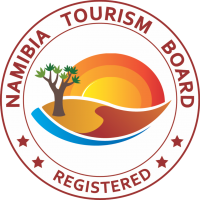
Etosha National Park (ENP) is Namibia’s pride and joy, and with good reason. Being one of Africa’s largest savannah conservation areas, ENP boasts in both size and variety of wildlife. This park, also known as Namibia’s greatest wildlife sanctuary, is home to 114 mammal species, abundant birdlife, various reptiles, amphibians and even fish. Some larger mammal species include elephant, oryx, springbok, giraffe, zebra, and predators like lions, leopards, cheetahs, hyaenas and jackals. The endemic, black-faced impala can also be seen in the park as well as both the black and white rhinos. The park’s waterholes are prime locations to spot various animals, ultimately guaranteeing game sightings.
ENP is centred around a white saline pan which is where the name comes from, meaning “place of emptiness” or “great white place”. The pan makes out a fifth of the park’s surface area, being one of Africa’s largest salt pans even visible from space. The Etosha pan also serves as a breeding place for around 1 million flamingos which have been encountered during years with especially good rainfall. The park covers 22 000 km2 located in the northern part of Namibia and is between 1000 – 1500 m above sea level. The vegetation in the park is made up of mostly mopane savannah, mixed shrubs and dry woodland surrounding the Etosha pan. The eastern and south-eastern parts of the park have the highest plant diversity with up to 500 species. The north-western parts of the park have mainly grasslands, and the eastern part has a denser bush environment due to heavier rainfall.
The park offers some facilities including accommodation, picnic spots, viewing decks, shops, and petrol stations. The main camps in ENP include Okaukuejo, Halali and Namutoni which offer both camping and lodge accommodation. Two additional camps, namely Dolomite and Onkoshi, offer more exclusive luxury chalets. Dolomite and Olifantsrus located on the western side of the park were always inaccessible to the public, but Olifantsrus now offers a new campsite for camping accommodation. The best time of the year to visit ENP is after the rainy season between May and November, during this time there is little water in the field making it more likely to spot wildlife at the waterholes. But, during the rainy season, it’s a prime time for bird sightings as the water attracts large numbers of resident and migratory birds. Do come visit this incredible park and see its wonder for yourself.
References
Etosha National Park. 2022. Etosha National Park – Namibia. [online] Available at: <https://www.etoshanationalpark.org> [Accessed 11 April 2022].
Humphreys, R., 2020. The Rough Guide to Namibia: With Victoria Falls. Rough Guides.
Mendelson, J., Jarvis, A., Roberts, C. and Robertson, T., 2009. Atlas of Namibia: A Portrait of the Land and its People. Cape Town.
Nolting, M., 2002. Africa’s Top Wildlife Countries. Global Travel Pub.




